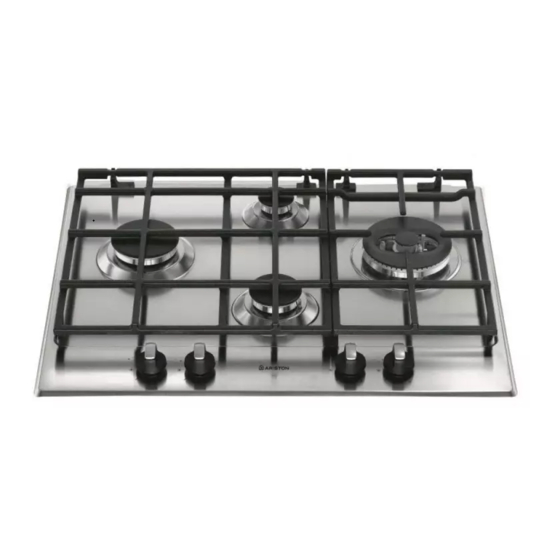Ariston PK 640 R GH AUS.1 Manuale di istruzioni per l'uso - Pagina 8
Sfoglia online o scarica il pdf Manuale di istruzioni per l'uso per Piano cottura Ariston PK 640 R GH AUS.1. Ariston PK 640 R GH AUS.1 32.

Pipe or Hose Connection
GB
This appliance is suitable for use with either a flexible connection or rigid
copper connection.
Either a rigid metal pipe with fittings in compliance with the standards in force
must be used for connecting to the nipple union (threaded ½"G male fitting)
situated at the rear of the appliance to the right (fig.8), or an approved flexible
hose of class B or D.
Should it be necessary to turn the fitting, the gasket (supplied with the
appliance) must be replaced.
If a flexible hose is used, it should be as short as possible with a maximum
length of 1.2 metres;
• the flexible connection must be approved to class B or D of AS/NZS1869
as a minimum.
• it should not be bent, kinked or compressed;
• it should not be in contact with the rear wall of the appliance or in any case
with parts which may reach a temperature of 50°C;
• it should not come into contact with pointed parts or sharp corners;
• it should not be subject to any pulling or twisting forces;
• it should be easy to inspect along its entire length in order to be able to
check its condition.
• The supply connection point must be accessible with the appliance
installed.
• The inner diameters of the pipe are as follows:
8 mm for LPG;
13 mm for Natural Gas.
Checking the tightness of the connection
Upon completion of installation, check the gas circuit, the internal connections
and the taps for leaks using a soapy solution (never a flame). Also check that
the connecting pipe cannot come into contact with moving parts which could
damage or crush it. Make sure that the natural gas pipe is adequate for a
sufficient supply to the appliance when all the burners are lit
Duplicate Data Plate
Where the data plate is obscured by cabinetry when the cooker is in the
installed position, place a duplicate data plate on a surface of the cabinetry
adjacent to the cooker.
Adapting to different types of gas
To adapt the hob to a different type of gas other than default type (indicated
on the rating plate at the base of the hob or on the packaging), the burner
nozzles should be replaced as follows:
1. Remove the hob grids and slide the burners off their seats.
2. Unscrew the nozzles using a 7 mm socket spanner, and replace them
with nozzles for the new type of gas (see table 1 "Burner and nozzle
characteristics").
3. Reassemble the parts following the above procedure in the reverse order.
4. Once this procedure is finished, replace the old rating sticker with one
indicating the new type of gas used. Sticker are available from any of our
Service Centres.
Replacing the nozzles on separate "double flame " burners
1. Remove the grids and slide the burners from their housings. The burner
consists of 2 separate parts (see figure);
2. Unscrew the burers with a 7 mm wrench spanner. The internal burner
has a nozzle, the external burner has two (of the same size). Replace
the nozzle with models suited to the new type of gas (see table 1).
3. Replace all the components by repeating the steps in reverse order.
8
Replacing the Triple ring burner nozzles
1. Remove the pan supports and lift the burners out of their housing. The
burner consists of two separate parts (see pictures).
2. Unscrew the nozzles using a 7 mm socket spanner. Replace the nozzles
with models that are configured for use with the new type of gas (see Table
1). The two nozzles have the same hole diameter.
3. Replace all the components by completing the above operations in reverse
order.
• Adjusting the burners' primary air :
Does not require adjusting.
• Setting the burners to minimum:
1. Turn the tap to the low flame position;
2. Remove the knob and adjust the adjustment screw, which is positioned
in or next to the tap pin, until the flame is small but steady.
! In the event of single-control DRDA (DCDR) burners, adjustment can be
performed by intervening on the 2 screws located near the tap pin (see picture).
3. Having adjusted the flame to the required low setting, while the burner is
alight, quickly change the position of the knob from minimum to maximum
and vice versa several times, checking that the flame does not go out.
4. Some appliances have a safety device (thermocouple) fitted. If the device
fails to work when the burners are set to the low flame setting, increase
this low flame setting using the adjusting screw.
5. Once the adjustment has been made, replace the seals on the by-passes
using sealing wax or a similar substance.
! If the appliance is connected to liquid gas, the regulation screw must be
fastened as tightly as possible.
! Once this procedure is finished, replace the old rating sticker with one
indicating the new type of gas used. Stickers are available from any of our
Service Centres.
Total DRDA
(DCDR) burner
adjustment
Inner DRDA (DCDR)
burner adjustment
